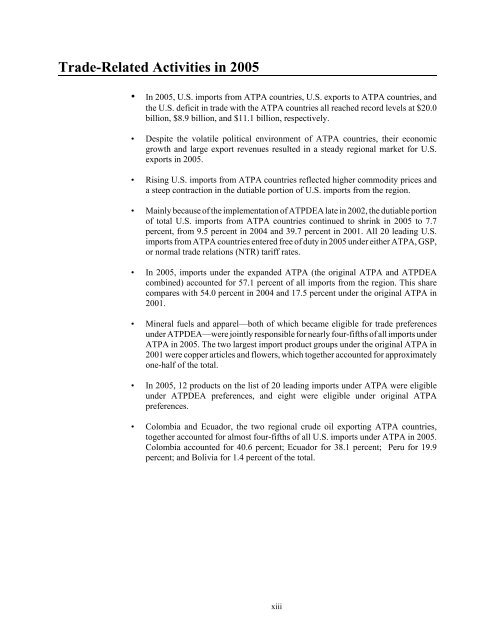CCC<strong>The</strong> overall effect <strong>of</strong> ATPA-exclusive imports on <strong>the</strong> U.S. economy continued to benegligible in 2005. In 2005, <strong>the</strong> value <strong>of</strong> duty-free U.S. imports under ATPAaccounted for about 0.7 percent <strong>of</strong> total U.S. imports, or 0.09 percent <strong>of</strong> <strong>the</strong> U.S.gross domestic product (GDP).Men’s or boys’ knitted cotton shirts provided <strong>the</strong> largest gain in consumer surplus($30 million to $34 million) from lower prices and higher consumption resultingexclusively from ATPA tariff preferences in 2005. Knitted cotton t-shirts provided<strong>the</strong> second-largest gain in consumer surplus ($22 million to $24 million). U.S.imports <strong>of</strong> all <strong>of</strong> <strong>the</strong> 20 leading ATPA-exclusive products produced net welfaregains (consumer surplus net <strong>of</strong> U.S. Treasury losses) for U.S. consumers in 2005.Men’s or boys’ knitted cotton shirts yielded <strong>the</strong> largest net welfare gain, valued at$4.0 million to $6.6 million, followed by knitted cotton t-shirts and men’s or boys’woven cotton trousers and shorts.<strong>The</strong> Commission’s economic and industry analyses indicate that U.S. industries thatmay have experienced displacement <strong>of</strong> more than 5 percent <strong>of</strong> <strong>the</strong> value <strong>of</strong> U.S.production in 2005, based on upper estimates, were those producing asparagus (2.9percent to 10.8 percent displacement, valued at $4.0 million to $14.8 million); freshcutroses (1.3 percent to 8.1 percent displacement, valued at $0.5 million to $3.2million); and chrysan<strong>the</strong>mums, carnations, anthuriums, and orchids (1.1 percent to6.5 percent displacement, valued at $0.3 million to $1.7 million).• <strong>The</strong> probable future effect <strong>of</strong> ATPA on <strong>the</strong> United States is expected to be minimalon <strong>the</strong> U.S. economy overall and in most economic sectors, even if U.S. tradepreferences were to continue in some form. Uncertainties related to <strong>the</strong> expiration<strong>of</strong> ATPA in December 2006 and <strong>the</strong> negotiation and implementation <strong>of</strong> bilateral freetrade agreements with <strong>the</strong> United States constrained investments in non-oil ATPArelatedsectors in 2005. Despite <strong>the</strong>se uncertainties, <strong>the</strong> Commission was able toidentify ATPA-related investments in textiles and apparel, flowers, jewelry, woodproducts, ethanol, fruits and vegetables, including asparagus and avocados, as wellas oil, which may generate increased exports to <strong>the</strong> United States in <strong>the</strong> future.However, stiff competition from China in <strong>the</strong> textile and apparel sector could limitfuture exports to <strong>the</strong> United States, even if trade preferences are continued.• In 2005, ATPA continued to have a small, indirect effect in support <strong>of</strong> illicit cocaeradication and crop substitution efforts in <strong>the</strong> <strong>Andean</strong> region. Net coca cultivationin <strong>the</strong> ATPA region remains at roughly its lowest level in two decades, although <strong>the</strong>dramatic declines in cultivation seen in Colombia since 2001 are being <strong>of</strong>fset partlyby annual average increases in Bolivia and Peru <strong>of</strong> approximately 5 percent since2001 . (<strong>The</strong> reported 38-percent surge in coca cultivation in Peru from 2004 to 2005is due in large part to expanded survey mapping, which counts areas not includedin previous U.S. Government estimates.) However, U.S. imports under ATPAcontinued to increase during 2005 and supported job growth in areas such as <strong>the</strong>asparagus and flower industries, <strong>the</strong>reby expanding alternatives to workers whomight o<strong>the</strong>rwise engage in drug-crop production. In addition, ATPA benefits appearto have directly supported <strong>the</strong> expansion <strong>of</strong> jobs for <strong>the</strong> production <strong>of</strong> o<strong>the</strong>ragricultural products as well as textiles and apparel in 2005.xii
<strong>Trade</strong>-Related <strong>Act</strong>ivities in 2005• In 2005, U.S. imports from ATPA countries, U.S. exports to ATPA countries, and<strong>the</strong> U.S. deficit in trade with <strong>the</strong> ATPA countries all reached record levels at $20.0billion, $8.9 billion, and $11.1 billion, respectively.• Despite <strong>the</strong> volatile political environment <strong>of</strong> ATPA countries, <strong>the</strong>ir economicgrowth and large export revenues resulted in a steady regional market for U.S.exports in 2005.• Rising U.S. imports from ATPA countries reflected higher commodity prices anda steep contraction in <strong>the</strong> dutiable portion <strong>of</strong> U.S. imports from <strong>the</strong> region.• Mainly because <strong>of</strong> <strong>the</strong> implementation <strong>of</strong> ATPDEA late in 2002, <strong>the</strong> dutiable portion<strong>of</strong> total U.S. imports from ATPA countries continued to shrink in 2005 to 7.7percent, from 9.5 percent in 2004 and 39.7 percent in 2001. All 20 leading U.S.imports from ATPA countries entered free <strong>of</strong> duty in 2005 under ei<strong>the</strong>r ATPA, GSP,or normal trade relations (NTR) tariff rates.• In 2005, imports under <strong>the</strong> expanded ATPA (<strong>the</strong> original ATPA and ATPDEAcombined) accounted for 57.1 percent <strong>of</strong> all imports from <strong>the</strong> region. This sharecompares with 54.0 percent in 2004 and 17.5 percent under <strong>the</strong> original ATPA in2001.• Mineral fuels and apparel—both <strong>of</strong> which became eligible for trade preferencesunder ATPDEA—were jointly responsible for nearly four-fifths <strong>of</strong> all imports underATPA in 2005. <strong>The</strong> two largest import product groups under <strong>the</strong> original ATPA in2001 were copper articles and flowers, which toge<strong>the</strong>r accounted for approximatelyone-half <strong>of</strong> <strong>the</strong> total.• In 2005, 12 products on <strong>the</strong> list <strong>of</strong> 20 leading imports under ATPA were eligibleunder ATPDEA preferences, and eight were eligible under original ATPApreferences.• Colombia and Ecuador, <strong>the</strong> two regional crude oil exporting ATPA countries,toge<strong>the</strong>r accounted for almost four-fifths <strong>of</strong> all U.S. imports under ATPA in 2005.Colombia accounted for 40.6 percent; Ecuador for 38.1 percent; Peru for 19.9percent; and Bolivia for 1.4 percent <strong>of</strong> <strong>the</strong> total.xiii
















